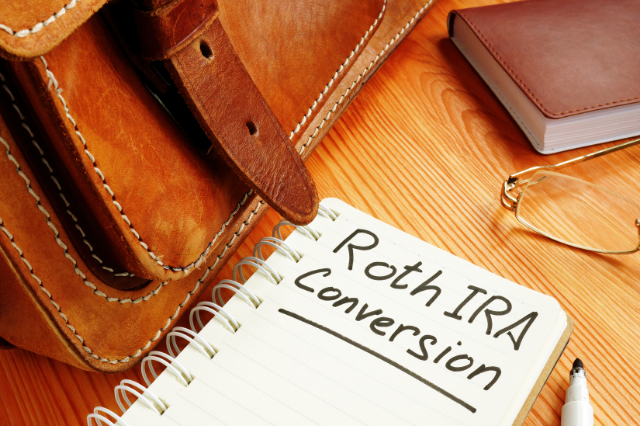In retirement, tax planning is one of the most crucial conversations. Minimizing your lifetime taxable income can better insulate your nest egg and give you more control over your spending throughout your golden years.
If you want to increase your Roth dollars in retirement, consider a Roth Conversion.
What’s a Roth Conversion?
Roth conversions allow high-income earners access to the tax benefits of a Roth IRA without contributing to the account directly. Roth IRAs have income limits for contributions. If you make too much for direct contributions, you can “convert” funds from your traditional IRA into a Roth IRA.
Why would retirees consider this action?
Because Roth IRAs are taxed differently than traditional IRAs, this can have several benefits for retirees, including:
- Tax-free distributions
- No RMDs, bringing more flexibility and control to how and when you use the funds.
- Additional options for retirement income planning
Roth conversions can offer many benefits, but it’s essential to plan for the conversions carefully.
Breaking Down Roth Conversions
There are several ways to convert money from a traditional IRA to a Roth IRA. You can complete a Roth IRA rollover, a trustee to trustee transfer, or the same trustee transfer.
Here’s the kicker: when you convert funds from a traditional to a Roth IRA, you’ll need to pay income tax on the conversion. It’s essential to prepare for this bump in your tax bill.
You should plan to initiate a Roth conversion during a low-income year to minimize your tax liability. Since the amount converted is considered taxable income, converting too much in an inopportune year could have other side effects like,
- Triggering net investment income tax (3.8%),
- Higher Medicare IRMAA (higher Part B premiums), and
- Additional Social Security tax (up to 85% of your benefits).
You should be sure that you have enough money set aside to pay the tax before you conduct a Roth conversion. Perhaps the last thing you want is a significant tax surprise come spring.
Tax planning isn’t reserved for springtime or year-end; it’s a year-round process. The middle of the year is a great time to capitalize on tax planning opportunities. Consider putting a plan in place to take advantage of a Roth conversion and minimize other taxable income.
Let’s explore three reasons Roth conversions can benefit retirees.
Roth IRAs are Tax-Free and Flexible
It’s easy to see one of the main benefits of a Roth IRA—qualified distributions are tax-free. This feature can save retirees a significant amount of money each year.
Unlike traditional IRAs and 401(k)s, Social Security income, and other brokerage accounts, withdrawals from a Roth IRA aren’t subject to income tax. By minimizing income tax, Roth IRAs can help retirees maximize retirement income.
It can also extend the shelf-life of your investments and allow you to manage your retirement investments over time more sustainably.
Roth IRAs bring more flexibility to your withdrawal strategy. If you have higher taxable income in a given year, you can withdraw funds from your Roth IRA instead of a traditional retirement account. This action minimizes your tax liability and helps keep your tax situation steady. Your retirement withdrawal strategy should be created to maximize your tax situation long-term.
Roth IRAs Don’t Have RMDs.
Roth IRAs are one of the only retirement accounts without required minimum distributions. This gives you more control over when you withdraw funds and can help you to calibrate your taxable income to minimize your tax burden.
Required minimum distributions for other types of retirement accounts like a 401(k) or traditional IRA can significantly increase your taxable income during a high-income year.
In contrast, Roth IRAs are much more flexible, allowing you to withdraw money when you need it and continue to grow your investments when you don’t.
A tip for retirees to minimize RMDs is to donate some to charity via a qualified charitable distribution (QCD).
Thinking of Your Heirs? Roth IRAs are a Great Inheritance Vehicle
Passed in 2019, the SECURE Act eliminated the “stretch” provision for inherited retirement accounts. Now, nearly all non-spouse beneficiaries need to withdraw funds from inherited retirement accounts within ten years. Because traditional IRAs add to taxable income, they could saddle your heirs with unnecessary tax strain during peak earning years.
But remember, Roth IRAs are different because qualified distributions aren’t taxed. Their tax-friendly treatment makes them an excellent inheritance vehicle.
As long as they adhere to the five-year rule, heirs usually do not have to pay taxes on inherited Roth IRAs. This also means that converting money from a traditional to a Roth IRA is an attractive estate planning tool.
Our Team Helps You Create a Retirement Income Plan That Lasts
Roth conversions are simply one tool in your overall retirement saving and investing plan.
To get the most benefit from this financial move, it’s a good idea to work with a knowledgeable professional to ensure that you minimize your tax burden while maximizing your savings and flexibility.
Whether you’re looking to maximize your retirement income, minimize your tax burden, or use a Roth conversion as an estate planning tool, we can help.
We specialize in retirement wealth management and retirement planning for individuals in or nearing retirement. Get in touch with us today to learn more!


